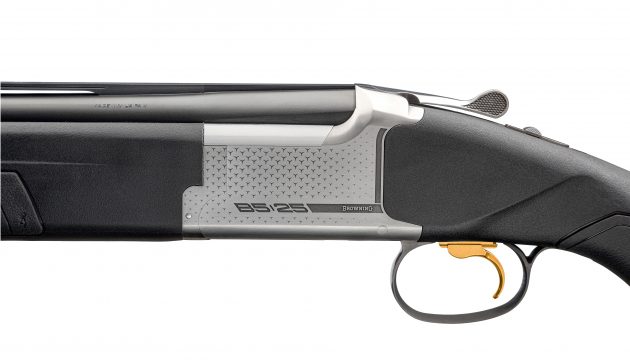Inspired by the classic B25 Superposed, the modern-looking, mid-weight Browning 525 Composite 12-bore over-and-under is a useful addition to the cabinet, says Michael Yardley
Browning 525 Composite 12-bore
This month’s test looks at a new Browning 525 Composite distinguished by a polymer stock with adjustable comb and sparse, modernistic engraving. There is an adjustable trigger too, as well as an 8mm sighting rib with fine cross-hatched surface, and vented side ribs. The mattblacked monobloc barrels are steel shot proofed and equipped with long, flush-fit Invector Plus multichokes. At just under 7½lb, the gun is mid-weight for a 30in 12-bore over-and-under: light enough to walk with but heavy enough to handle bigger payloads if required.

First impressions of the Composite are dominated by its black synthetic stock. This did not appeal initially. Most like the beauty of natural wood and a bit of engraving (if well done). However, times are a-changin’. The three-pointed star etching grew on me. Although the stock is utilitarian – something similar was introduced on the modernistic Cynergy circa 2010 – the shapes are sound and the rubberised gripping surfaces offer exceptional hold. You could easily imagine the Composite on a wet marsh or in a hide.
Recent laminate wood versions of the 525, such as that tested in The Field in June 2019, have impressed. They blend radical changes in stock material with a traditional Browning/Miroku action. Their tough glued-sandwich woodwork adds weight but they surprised me with a lack of felt recoil. Will the lighter Composite kick more? All will be revealed but, while dry mounting the new gun, a significantly forward balance was evident with the relatively light butt. The general handling dynamic was pleasing.
The Browning 525 Composite is based on a mechanical design probably better proven than any other over-and-under; John Moses Browning died at his Herstal workbench still perfecting it in 1926. His son Val was left to complete the single trigger, which has since been redesigned. The B25 Superposed has inspired many guns, not least the 525 tested (which, like the Browning 425 and 325, is a Japanese-made evolution of it with certain simplifications to aid manufacture). On the B25 the lumps are beneath the barrel, unlike on the more expensive English Boss and Woodward guns preceding it, and it includes a full-width hinge pin rather than the bifurcated lump/trunnion hinging arrangement used by Woodward and later adopted by Beretta and others. Lock-up is achieved by means of a flat bolt emerging from the bottom of the breechface engaging a slot bite beneath the bottom chamber.
The B25 first appeared in Britain in the mid-1930s. Accessibly priced, it would do much to establish the stack-barrelled configuration. In 1939 cost with a double trigger was £19 10s (a single trigger was £8 extra). A few early guns were made in Boss style without a top rib. Stock dimensions were 14½in for length and 1½in and 2in for drop – arguably better for drop than the modern norm of 1½in and 2¼in. Browning experimented with stock dimensions and rib types. Many early guns had semi-pistol grips but a full pistol became the standard pattern and one yet to be bettered.

In 1960 BC Miroku started marketing (increasingly good) B25 copies. A decade later FN Herstal, which would acquire Browning, sent representatives to Japan. Some work had already been outsourced to Miroku since 1965. After negotiations, a new line of Miroku-built Browning B25- style guns emerged. The Citori models (3, 4 and 525) have all been successful. Bespoke bench-made guns are still produced at Browning’s Custom Shop in Herstal. They now co-exist with the Japanese-manufactured Brownings (and Mirokus). Browning once told his son Val: “… there is a market for a reasonably priced over-and-under shotgun, which will be one of the last shotguns to be legislated out of business”. We may hope he was right.
Technical
The Browning 525 is an evolution of the Browning Citori and the Mirokus that preceded it. The Citori first appeared in 1973, a year after the company had introduced a Miroku-made side-by-side into its line and five years after the first Japanese Browning shotgun, the BT-99 single-barrel trap. The Citori was similar to a Belgian B25 but had a detachable fore-end and no cut-away in the action belly to accommodate the B25’s hinged fore-end extension. It evolved into the 325, 425 and (still current) 525 models. Midway through the production cycle of the 425, chopper-lump barrels were replaced with monobloc ones. Later, longer Invector Plus multichokes replaced standard Invectors, and barrels and chambers were internally hard-chromed to increase longevity. Save choking, the basic mechanics and dimensions of the 25 series guns remain virtually unchanged. The 725 launched in 2012, however, was a distinct redesign to achieve a lower action profile.
Shooting impressions
I expected the Composite to kick more than heavier laminated siblings. Surprisingly, it didn’t. The butt seems a bit hollow but this forward-weighted gun shoots well. Laminate versions may kick less because of extra mass but something else might be happening here. Could the ‘plastic’ stock be absorbing recoil energy? Straight-grained timber can increase felt recoil, in my experience. Even with the adjustable comb set lower than preferred, this Browning immediately inspired shooting confidence. The chokes – 1/2 and 1/4 – provided great breaks on clays. Trigger-pulls were fine, breaking around 3½lb and 4lb, and the 8mm rib was ideal. Particularly efficient too was the relatively small grip, replacing conventional chequering with a rubberised, stipple-less surface giving outstanding purchase. Furthermore, the Composite is well priced.
Browning 525 Composite
RRP: £2,030 (standard wooden Sporter 1: £1,910)
BWM Arms, Unit 2 Moorbrook Park, Hawksworth, Didcot, Oxfordshire OX11 7HP
Tel: 01235 514550
Visit: browning.eu




